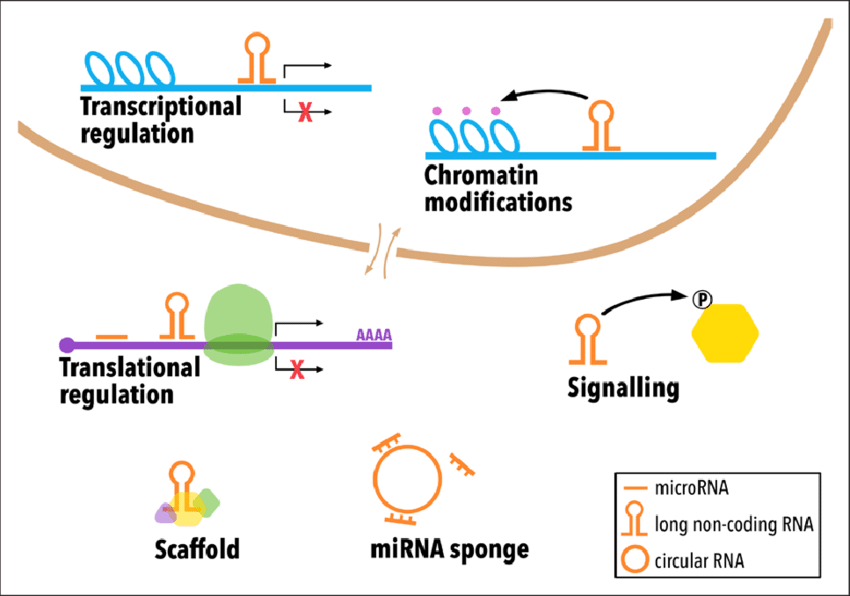Demystifying Non-Coding RNA: The Silent Regulators of Gene Expression

For decades, DNA held the starring role in the drama of life, containing the instructions to build proteins that orchestrate cellular functions. But recent research has revealed a whole new cast of characters: non-coding RNAs (ncRNAs). These unsung heroes, despite not coding for proteins themselves, play a critical role in regulating gene expression, the process by which DNA instructions are translated into action.
The Diverse Cast of ncRNAs:
ncRNAs are a vast and varied group, but two key players deserve a spotlight:
- MicroRNAs (miRNAs): These tiny molecules, with only about 20 nucleotides, act as silencers. They bind to messenger RNA (mRNA), the intermediary molecule carrying genetic instructions, and either block its translation into protein or mark it for degradation. This allows miRNAs to fine-tune gene expression by strategically reducing protein production.
- Long non-coding RNAs (lncRNAs): In contrast to miRNAs, lncRNAs are much larger, ranging from hundreds to thousands of nucleotides. They function as both silencers and enhancers, wielding their influence through various mechanisms. LncRNAs can interact with DNA, RNA-binding proteins, or other ncRNAs to influence chromatin structure, mRNA stability, and ultimately, gene expression.
The Power of Silence and Amplification:

By acting as silencers or enhancers, ncRNAs control the cellular orchestra. When a gene product is no longer needed, miRNAs can step in and silence its production. Conversely, lncRNAs can activate silent genes or boost the production of essential proteins. This intricate dance of regulation allows cells to respond dynamically to their environment and maintain a healthy balance.
Beyond the Stage: ncRNAs in Disease and Therapy:

The discovery of ncRNAs has opened exciting new avenues in medicine. Since ncRNA dysregulation is linked to various diseases, including cancer, neurological disorders, and cardiovascular diseases, these molecules hold immense potential as biomarkers. By analyzing ncRNA profiles, scientists may be able to diagnose diseases earlier and more effectively.
Furthermore, ncRNAs themselves are emerging as therapeutic targets. By manipulating ncRNA activity, researchers hope to develop drugs that can restore a healthy balance of gene expression in diseased cells. This field of ncRNA therapeutics is still in its early stages, but it holds immense promise for the future of personalized medicine.
In Conclusion:

While DNA may have been the first star, ncRNAs are stealing the show. These versatile molecules play a critical role in regulating gene expression, shaping the intricate dance of life within our cells. As we continue to unravel the mysteries of ncRNAs, they hold the potential to revolutionize our understanding of disease and pave the way for novel therapeutic strategies.
Delving into the Regulatory Maze: The Intricacies of ncRNA Control

Beyond Binary Silencing and Enhancement:
While miRNAs and lncRNAs are often categorized as gene silencers or enhancers, their regulatory influence extends far beyond these simplistic labels. To fully grasp the complexities of ncRNA regulation, we must venture beyond these surface-level descriptions and explore the intricate nuances that govern their actions.
Context-Dependent Effects:
The impact of an ncRNA can vary dramatically depending on the cellular context. An miRNA that silences a gene in one cell type might act as an enhancer in another. This context-dependency is shaped by a multitude of factors, including the presence of other regulatory molecules and the specific sequence of the target mRNA.
Cooperative and Competitive Dynamics:
ncRNAs rarely operate in isolation. They often form intricate networks, where miRNAs can compete for the same mRNA binding site, while others may collaborate to achieve a specific regulatory outcome. Additionally, ncRNAs can interact with other regulatory proteins, further fine-tuning gene expression.
Epigenetic Modulation:

ncRNAs can exert their influence beyond direct gene silencing or enhancement. They can also influence chromatin structure, the tightly packed form of DNA in the nucleus. By modifying chromatin accessibility, ncRNAs can indirectly regulate gene expression by making DNA regions more or less accessible to transcription machinery.
Alternative Splicing Regulation:
Some ncRNAs can influence how pre-mRNA (immature mRNA) is spliced, a process that removes introns (non-coding regions) and joins exons (coding regions) to form mature mRNA. By altering splicing patterns, ncRNAs can influence the final protein product generated from a single gene.
Translational Control:
Certain ncRNAs have the ability to regulate the process of translating mRNA into protein. They might achieve this by binding to ribosomes (protein-building machines) or by directly interacting with the mRNA itself, influencing its translation efficiency.
Demystifying the Regulatory Landscape:

Elucidating the diverse regulatory mechanisms employed by ncRNAs is paramount to unlocking their contributions to development, cell differentiation, and disease progression. Deciphering the intricate network of ncRNA interactions holds the key to understanding how cells meticulously control gene expression. Furthermore, it sheds light on how disruptions within this network might contribute to the development of various pathologies.
Navigating the Complexity:
The study of ncRNA regulation is a rapidly evolving field, constantly revealing new layers of complexity and sophistication. As researchers delve deeper into this intricate world, they are uncovering the profound impact of ncRNAs on cellular processes and their potential as biomarkers and therapeutic targets. By embracing the challenges and opportunities presented by this complex regulatory landscape, we can hope to gain a deeper understanding of the fundamental mechanisms of life and pave the way for novel therapeutic strategies.
In conclusion, ncRNAs play a critical role in regulating gene expression, with diverse mechanisms influencing various cellular processes. These findings hold promise for the development of novel gene editing strategies, paving the way for a deeper understanding of disease and the potential for future therapeutic interventions.


